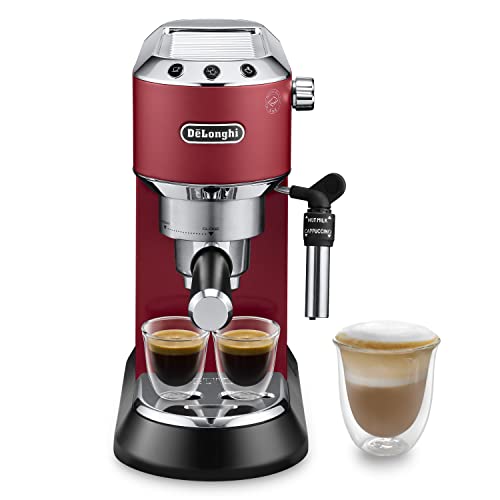10 Apps That Can Help You Control Your Commercial Espresso Machine
2024.11.24 04:51
 What to Look For in a Commercial Espresso Machine
What to Look For in a Commercial Espresso MachineThere are a myriad of things to consider when purchasing a commercial espresso machine. The type of espresso machine right for your cafe will be determined by the quantity of use, the purpose, and barista's abilities.
A double boiler system gives the ability to brew and steam simultaneously. It also decreases the time between pulls. Proportional-integral-derivative (PID) temperature control manages on/off cycles for optimal boiler temperatures.
Productivity
A commercial espresso machine is designed to handle a larger amount of coffee machine espresso than a home espresso machine. If you expect a home espresso maker to work in a professional setting would be an invitation to disaster.
A commercial machine of top quality can provide up to 100 coffee cups per hour during peak hours. This can be an enormous help in busy workplaces, since it stops employees from waiting for hours to get their coffee.
Coffee machines can help workers connect. Sometimes, teams of people have a turn getting coffee for each other which can promote teamwork and collaboration in the workplace. A dedicated space to enjoy coffee can aid new employees in feeling at peace in the workplace, removing any barriers between them and the senior staff members.
Commercial espresso machines are available in a variety of sizes to cater for different requirements. Some models are purely automatic while others are able to prepare espresso shots beforehand so that operators don't have to guess the right size of the shot. This is particularly crucial for businesses with inexperienced baristas, as incorrect shots can drastically affect the intensity and flavor of brewed espresso. It is also advisable to buy commercial espresso machines made of ethically-sourced materials that support the communities where coffee beans are harvested. This will ensure that the coffee is of top quality and reduce the negative impact on the environment.
Safety
Espresso machines are big heavy pieces of equipment that can cost more than a brand new compact espresso machine car. The machines are designed to create hundreds of drinks and shots in the course of a single day. Commercial espresso machines could pose particular health and safety hazards to staff due to their high volume.
It's important bean to cup espresso machines (Full Guide) keep it in mind that a commercial espresso machine is likely to be operating with warm water, which could increase the growth of bacteria. A machine that isn't maintained properly and hasn't been cleaned or descaled regularly may start to accumulate spent espresso, which could become rancid and cause illnesses if consumed by consumers. A commercial espresso machine with steam wands that don't have an effective seal may allow for the growth of bacterial in the milk frothing system, because it might not be able to attain temperatures high enough to kill all bacteria.
When you are choosing a commercial espresso machine, it is important to think about the type of beverages you plan on serving and the amount of cups per hour your space can handle. You should also look for an espresso machine that has automated features, which make it simpler and quicker to serve your patrons their favorite coffee drinks. In addition, look for a guarantee that covers parts and labor to ensure that any technical issues are addressed quickly and effectively.
Energy Efficiency
Commercial espresso machines require considerably more power than the home models. This is because professional espresso machines are built with heavier frames and larger boilers to handle the multiple group heads required for standard cafe production. These machines operate at higher temperatures and are usually placed inside (such as in a cafe or restaurant) where the electronics can overheat.
The boiler of an espresso machine designed for commercial use heats and stores water that has been pressurized by an electric pump. This water is then used for brewing and steaming espresso. The boiler is made up of several copper tubes that are heated by electric elements. When the brew sensor detects that the water level has reached the target level the solenoid valve will open and fills the boiler with new water. The heating element is then turned off.
There are four variants of espresso machines, differentiated by their capacity to steam and brew with steam: TBS (brewing only), TX (twin boilers), HX, and DA (double automatic). TB and TX machines have stable brew temperatures, while DA can provide rapid steaming using only one boiler. Many cafes are converting to HX machines since they have been shown to offer the best of both worlds, in terms of steam and brew temperatures.
Maintenance
Commercial espresso machines require regular maintenance just like cars. They must be maintained to work efficiently and smoothly. If you maintain your machine it will provide you with a better tasting coffee and it will last longer.
Cleaning your espresso machine is a regular ritual, but it's essential to clean your machine on a greater scale. There are traces of coffee grounds and other milk products that could cause the machine to break down over time. Regular cleaning will keep your espresso machine in tip-top condition.
Most commercial espresso machines espresso machines require descaling at least every 3 months. This process requires additional steps over regular cleaning, so it's best check your manual regularly to ensure that you're adhering to the instructions. The solution used to descal the tank in the water tank dissolves scale. To accomplish this you'll need an item under the steam wand and in some models, underneath the coffee spouts. Then, follow the instructions specific to your model.
Another important maintenance step is to change the water filters. It's easy to forget but it's crucial not to build up mineral deposits. You'll also want to check for calcification in the spray head, which can be difficult to remove.